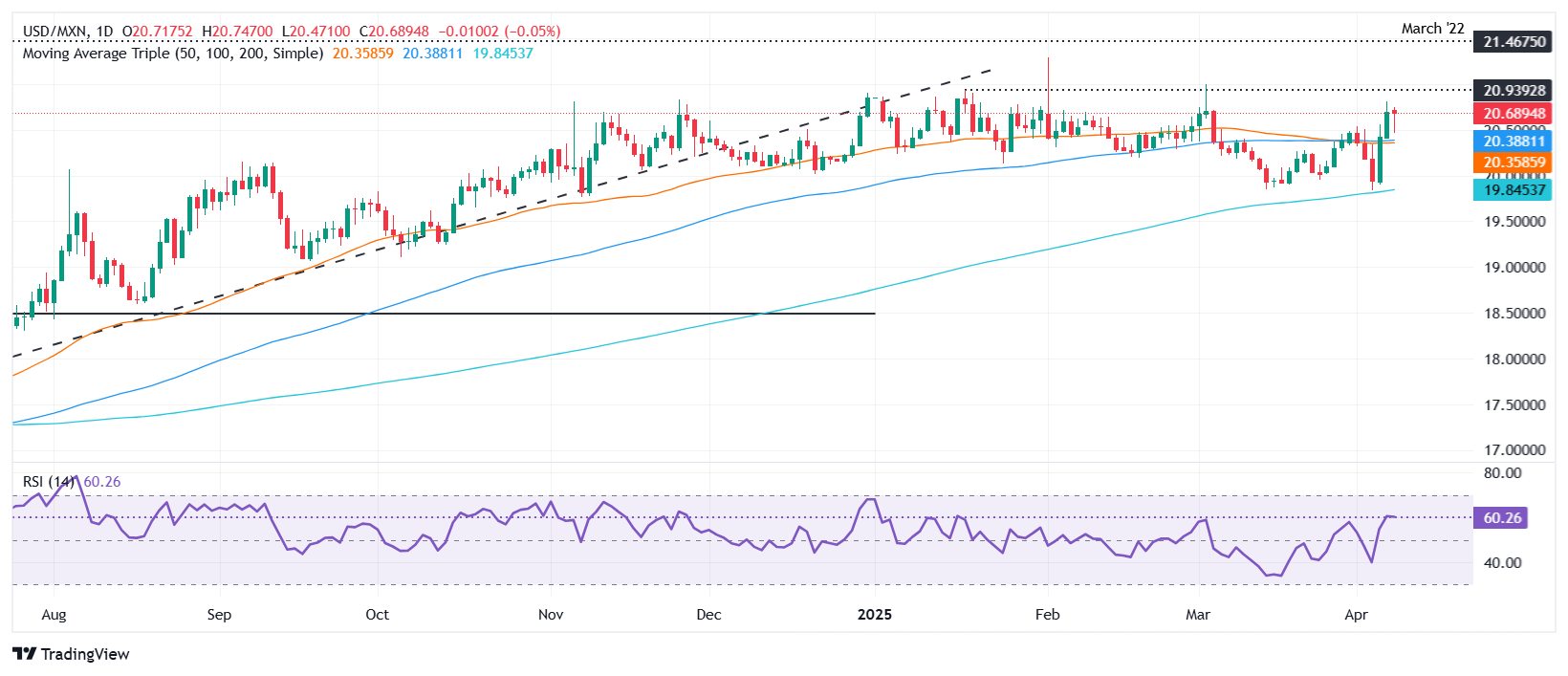Created
: 2025.04.09














![]() 2025.04.09 02:52
2025.04.09 02:52
The Mexican Peso prolonged its losses for the third straight day against the Greenback as market sentiment improved, spurred by revelations of US Treasury Secretary Scott Bessent that deals could be made with major trading partners. At the time of writing, the USD/MXN trades at 20.72, up 0.25%.
As of this writing, the global equity sell-off has paused, yet bulls are not out of the woods, even though Bessent's words provide hope. Nevertheless, news broke that the White House confirmed that 104% tariffs on China went into effect at 12:00pm EST
The Peso weakened slightly on the headlines amid a scarce economic docket. USD/MXN traders are awaiting the release of the Consumer Price Index (CPI) for March, which is expected to rise slightly.
Citi Mexico Expectations Survey hints that most economists project further easing by Banco de Mexico (Banxico), which is expected to cut rates 50 basis points (bps) in May. The USD/MXN exchange rate would likely remain below 21.00, and the economy is expected to grow less than expected in the previous survey.
Across the border, Chicago Fed Governor Austan Goolsbee crossed the wires, saying that tariff rates are much more than what the Fed had been modelling. On the data front, the schedule is absent, yet investors are eyeing the release of the Fed's latest minutes, alongside US CPI and PPI data.
The uptrend remains in place as the USD/MXN cleared the confluence of the 50-day and 100-day Simple Moving Averages (SMAs) near 20.34/36, keeping the rally alive. On further strength, buyers could challenge the March 4 peak at 20.99, followed by the year-to-date (YTD) high of 21.28.
Conversely, if USD/MXN falls below 20.34, the first support will be the psychological 20.00 figure. A breach of the latter will expose the 200-day SMA at 19.80.

The Mexican Peso (MXN) is the most traded currency among its Latin American peers. Its value is broadly determined by the performance of the Mexican economy, the country's central bank's policy, the amount of foreign investment in the country and even the levels of remittances sent by Mexicans who live abroad, particularly in the United States. Geopolitical trends can also move MXN: for example, the process of nearshoring - or the decision by some firms to relocate manufacturing capacity and supply chains closer to their home countries - is also seen as a catalyst for the Mexican currency as the country is considered a key manufacturing hub in the American continent. Another catalyst for MXN is Oil prices as Mexico is a key exporter of the commodity.
The main objective of Mexico's central bank, also known as Banxico, is to maintain inflation at low and stable levels (at or close to its target of 3%, the midpoint in a tolerance band of between 2% and 4%). To this end, the bank sets an appropriate level of interest rates. When inflation is too high, Banxico will attempt to tame it by raising interest rates, making it more expensive for households and businesses to borrow money, thus cooling demand and the overall economy. Higher interest rates are generally positive for the Mexican Peso (MXN) as they lead to higher yields, making the country a more attractive place for investors. On the contrary, lower interest rates tend to weaken MXN.
Macroeconomic data releases are key to assess the state of the economy and can have an impact on the Mexican Peso (MXN) valuation. A strong Mexican economy, based on high economic growth, low unemployment and high confidence is good for MXN. Not only does it attract more foreign investment but it may encourage the Bank of Mexico (Banxico) to increase interest rates, particularly if this strength comes together with elevated inflation. However, if economic data is weak, MXN is likely to depreciate.
As an emerging-market currency, the Mexican Peso (MXN) tends to strive during risk-on periods, or when investors perceive that broader market risks are low and thus are eager to engage with investments that carry a higher risk. Conversely, MXN tends to weaken at times of market turbulence or economic uncertainty as investors tend to sell higher-risk assets and flee to the more-stable safe havens.
![]()
Created
: 2025.04.09
![]()
Last updated
: 2025.04.09

FXStreet is a forex information website, delivering market analysis and news articles 24/7.
It features a number of articles contributed by well-known analysts, in addition to the ones by its editorial team.
Founded in 2000 by Francesc Riverola, a Spanish economist, it has grown to become a world-renowned information website.
We hope you find this article useful. Any comments or suggestions will be greatly appreciated.
We are also looking for writers with extensive experience in forex and crypto to join us.
please contact us at [email protected].
Disclaimer:
All information and content provided on this website is provided for informational purposes only and is not intended to solicit any investment. Although all efforts are made in order to ensure that the information is correct, no guarantee is provided for the accuracy of any content on this website. Any decision made shall be the responsibility of the investor and Myforex does not take any responsibility whatsoever regarding the use of any information provided herein.
The content provided on this website belongs to Myforex and, where stated, the relevant licensors. All rights are reserved by Myforex and the relevant licensors, and no content of this website, whether in full or in part, shall be copied or displayed elsewhere without the explicit written permission of the relevant copyright holder. If you wish to use any part of the content provided on this website, please ensure that you contact Myforex.
Myforex uses cookies to improve the convenience and functionality of this website. This website may include cookies not only by us but also by third parties (advertisers, log analysts, etc.) for the purpose of tracking the activities of users. Cookie policy